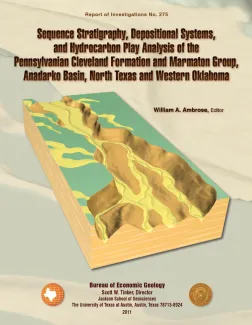
Publication Details
Geolocation:
Get the Publication
$16.00
Abstract/Description:
This report provides a detailed review of the stratigraphic and structural attributes and controls on productivity and future potential of the Cleveland Formation and Marmaton Group by integrating chronostratigraphic, depositional-facies, and play analysis. Its authors used a data set consisting of 1,127 wells and 5 conventional cores with ~250 ft of section from the Cleveland Formation, along with production data from more than 900 wells in the Cleveland and Marmaton. This report is the first published study to define, map, and characterize gas and oil plays systematically in the Cleveland and Marmaton using a sequence-stratigraphic and structural framework. Although gas production from the low-permeability, tight Cleveland Formation and underlying Marmaton Group in the northwest Anadarko Basin dates from the late 1950’s, the sequence-stratigraphic setting and facies architecture of reservoir sandstones in the primary producing area in the basin have yet to be fully characterized. The Cleveland Formation, as of June 2010, had produced 1.1 trillion cubic feet (Tcf) of gas and 37.3 million barrels of oil (MMbbl) from low-permeability (tight) sandstones in a play area that comprises Ochiltree and Lipscomb Counties, Texas, and adjacent Ellis County, Oklahoma. In addition, siliciclastics of the Marmaton Group over the same period have produced 14.0 million cubic feet of gas (MMcf) and 1.5 MMbbl of oil from the same area. These producing intervals are part of a productive trend of tidally modified, shallow-marine sandstones (Missourian Shallow-Marine Sandstone play; Bingham, 1993) in the Anadarko Basin, which encompasses the Texas Panhandle and western Oklahoma (Rascoe and Adler, 1993). Sandstones in the Cleveland Formation and Marmaton Group commonly require hydraulic fracturing and/or horizontal drilling to maximize permeability pathways and enhance productivity. Important issues that affect the success of these horizontal wells include sandstone body thickness and lateral continuity and geometry, as well as degree of interbedded siltstones that increase matrix content, thereby reducing overall porosity and reservoir quality. The primary, collective objective of the three articles that compose this report is to provide a detailed review of the stratigraphic and structural attributes and controls on productivity and future potential of the Cleveland Formation and Marmaton Group by integrating chronostratigraphic, depositional facies, and play analysis. This investigation expands on previous studies of the Cleveland Formation by Hentz (1994a, b). It provides more detailed analysis of facies by using a larger data set, as well as by relating sequence-stratigraphic and facies controls on sandstone-body distribution and reservoir continuity. This study also includes a play analysis of the Marmaton Group, which has a depositional origin similar to that of the Cleveland Formation. The study uses a data set consisting of 1,127 wells and 5 conventional cores with approximately 250 ft (~75 m) of section from the Cleveland Formation, as well as production data from both the Cleveland Formation and Marmaton Group from more than 900 wells. This is the first study to define, map, and characterize gas and oil plays systematically in the Cleveland Formation and Marmaton Group using a sequence-stratigraphic and structural framework. Robust sequence-stratigraphic and depositional facies frameworks that accurately predict the complex sandstone-body and facies geometry within the Cleveland Formation and Marmaton Group are necessary for controls on their reservoir quality and continuity to be completely understood.